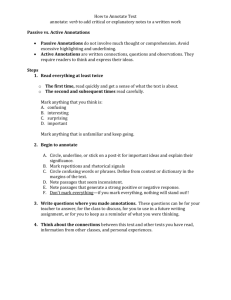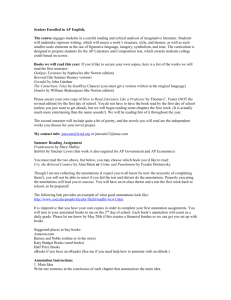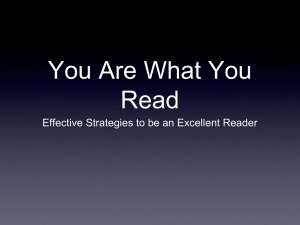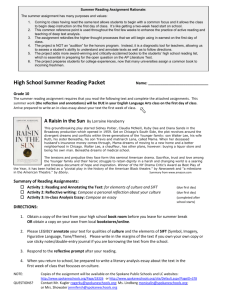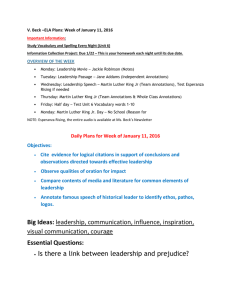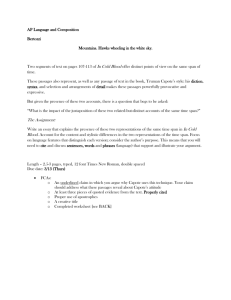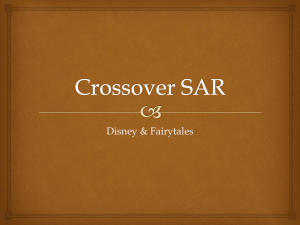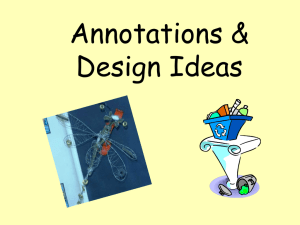Honors Eng 2015-16 overview of summer reading
advertisement
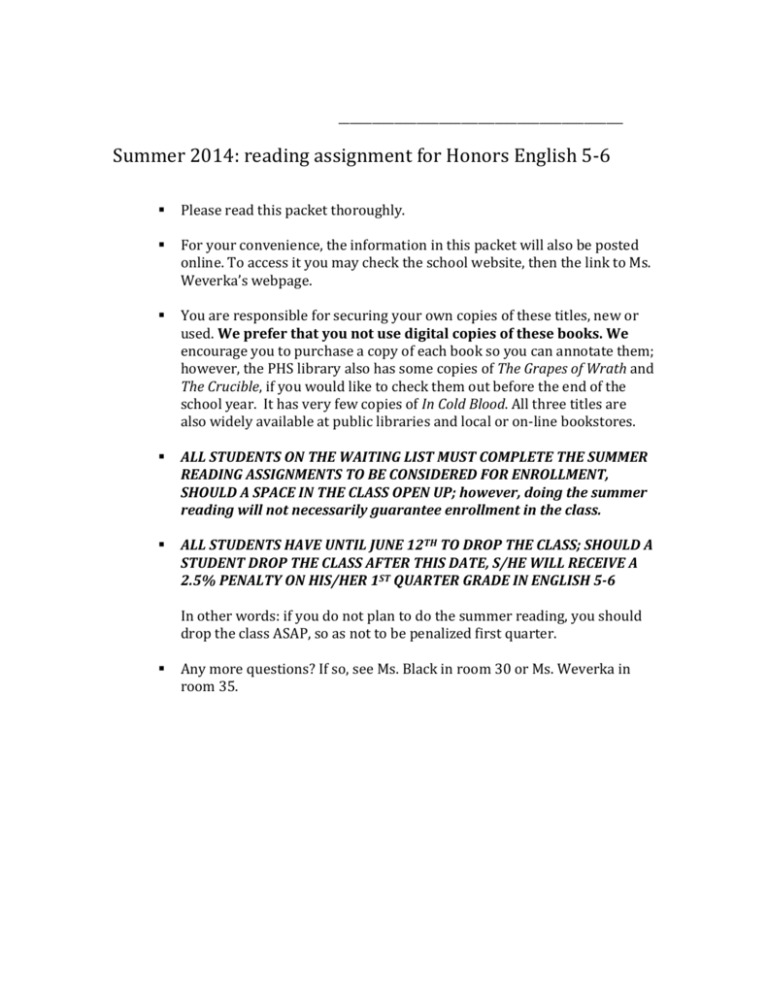
___________________________________________________ Summer 2014: reading assignment for Honors English 5-6 Please read this packet thoroughly. For your convenience, the information in this packet will also be posted online. To access it you may check the school website, then the link to Ms. Weverka’s webpage. You are responsible for securing your own copies of these titles, new or used. We prefer that you not use digital copies of these books. We encourage you to purchase a copy of each book so you can annotate them; however, the PHS library also has some copies of The Grapes of Wrath and The Crucible, if you would like to check them out before the end of the school year. It has very few copies of In Cold Blood. All three titles are also widely available at public libraries and local or on-line bookstores. ALL STUDENTS ON THE WAITING LIST MUST COMPLETE THE SUMMER READING ASSIGNMENTS TO BE CONSIDERED FOR ENROLLMENT, SHOULD A SPACE IN THE CLASS OPEN UP; however, doing the summer reading will not necessarily guarantee enrollment in the class. ALL STUDENTS HAVE UNTIL JUNE 12TH TO DROP THE CLASS; SHOULD A STUDENT DROP THE CLASS AFTER THIS DATE, S/HE WILL RECEIVE A 2.5% PENALTY ON HIS/HER 1ST QUARTER GRADE IN ENGLISH 5-6 In other words: if you do not plan to do the summer reading, you should drop the class ASAP, so as not to be penalized first quarter. Any more questions? If so, see Ms. Black in room 30 or Ms. Weverka in room 35. Honors English overview of summer reading: I. Required reading: 1. The Grapes of Wrath by John Steinbeck 2. In Cold Blood by Truman Capote 3. The Crucible by Arthur Miller II. Required Tasks While Reading 1. Mark and annotate each book as you read (if you own the book). See the attached pages to learn the specific focus for your notes or annotations in each book. Annotations MUST BE INSIDE THE BOOK ITSELF, ON OR VERY NEAR THE PAGE OF EACH ANNOTATED QUOTATION. and may include your analyses, insights, responses, comments or questions. Looking for patterns can be very useful. Annotations do not need to be complete sentences—just words or phrases are acceptable. Do not use the annotations to simply repeat or label a fact (like the plot, or a writing technique). Your goal is to reach another layer of insight. Or, if you do not own the book (or would rather not write in the book), then follow the guidelines above and Identify page numbers of significant passages as you read, taking notes on your analyses, insights, responses, comments or analytical questions to these passages. You may put the annotations on a on a series of post-its or on a series of 3 X 5 cards (that you stick or tuck right into the book, on or very near the page of each annotated quotation). Be sure to keep track of pages/quotations as you do so. III. Due dates: All of the reading and annotations or notes must be completed by the second day of class in the Fall. On the second day of class in the Fall… -Your notes/annotations will be checked AND -You may expect to take a detailed comprehension quiz. Annotations or Notes These annotations or notes will be the foundation of discussion and writing in the first weeks of class. The goal is to add depth and insight to your reading, and to help you make meaning of the work. Remember to look for patterns developing. It is important to be an ACTIVE, responsive reader. And again, THEY MUST BE PLCED INSIDE THE BOOK ITSELF, ON OR VERY NEAR THE PAGE OF EACH ANNOTATED QUOTATION. I. The Crucible Choose ONE (or two, if you are feeling ambitious) of these basic literary devices: An important Character, Symbol, Conflict or Theme; or the Setting Follow the development of this character, symbol, (or series of symbols) conflict, setting or theme throughout the play as you read. Try to mark references in the beginning, middle and end of the play. Identify at least TEN quotes or passages that reveal this development. Annotate or take notes on each marked quotation or passage. A brief analysis, response, insight, or analytical question is acceptable. II. The Grapes of Wrath Choose at least TWO recurring images, symbols, motifs or themes below to follow throughout the book as you read. Try to mark references in the beginning middle and end of the book. For EACH thread you follow, identify at least TEN quotes or passages. (So, to clarify: you will mark a minimum of 20 quotes or passages in the book, at least 10 for each thread you are following). Annotate or take notes on each marked quotation or passage. A brief analysis, response, insight or analytical question is acceptable. Possible Images, symbols or themes to follow. You must choose from this list: 1) Nature (imagery or symbols associated with land, plants, weather etc...) 2) Animal (imagery or symbols) 3) Hunger (literal, spiritual, emotional) and food 4) The Journey/The Road/Movement/Migration (literal, spiritual, emotional etc...) 5) Unity (or lack of it)... the “I” vs. the “We” 6) Ownership (or lack of it) 7) Spirituality/religion/ Biblical allusions and biblical parallels 8) Machines 9) The role of women 10) Birth/rebirth III. In Cold Blood: We will use this book as a foundation for our discussion of “how writer’s write” and the writer’s craft. So, while of course we are interested the ideas and themes of In Cold Blood, we will specifically examine how Capote’s writing style or writing techniques help create meaning in this book. See the attached list of rhetorical devices and other writing techniques for possibilities. Identify at least TEN quotes or passages in the book where Capote makes a significant writing choice. Annotate or take notes on each marked quotation or passage. How does the writing choice (the technique or device) help create meaning? Looking for patterns can be especially useful here. A brief analysis, response, insight, analytical question or analysis is acceptable. Other tips: Remember that your goal is to examine how Capote’s writing style helps add to the meaning of the work overall, so you must keep overall themes in mind to do this. Simply identifying the example of the technique or device is not as useful as considering how it creates meaning, or how it adds to the piece and its themes. You do not need to pick a different technique or device for each quote. Rhetorical Devices and other Writing Techniques Remember, the goal is not to simply point out when a writer uses a technique (“Wow- here’s a simile!”) but to understand the impact of that writing choice. NEVER SUBSTITUTE TERMINOLOGY FOR ANALYSIS. Aim to make meaning. ad hominem argument- appealing to one’s emotion, rather than reason, as in attacking one’s opponent rather than debating the issue allegorical- using allegory (stories that have hidden or symbolic characters, items, events, etc...); describes when ideas are presented through symbolic stories alliteration- repetition of an initial consonant sound. allusion- a reference; a casual or indirect reference analogy- comparison anaphora- repetition of words (at the start of a sentence); repetition of the same word or phrase at the beginning of successive clauses or verses. anecdote: a short, entertaining account of an incident; a story; antecedent- that which comes before antipathy- a strong dislike; an aversion antithesis - the juxtaposition of contrasting ideas in balanced phrases. appeals (rhetorical): - ethos - that which appeals to our ethics or morals (trustworthiness, common values) - logos- that which appeals to an audience’s reason (like facts, statistics, hard evidence) - pathos- the quality in something experienced or observed which arouses feeling or emotion like pity, sympathy, sorrow or compassion apostrophe – breaking off discourse to address some absent person or thing, some abstract quality, an inanimate object, or a nonexistent character. : a sudden turn from the general audience to address a specific group or person or personified abstraction absent or present. *For Brutus, as you know, was Caesar's angel. Judge, O you gods, how dearly Caesar loved him. Shakespeare, Julius Caesar archaism- the use of archaic (antiquated, ancient, from a much earlier time period) words or techniques assonance - identity or similarity in sound between internal vowels in neighboring words. begging the question- to use an argument that assumes as proved the very thing that is being proved. beginning and ends (of the book, of chapters, of paragraphs…) candor- honesty chiasmus - a verbal pattern in which the second half of an expression is balanced against the first but with the parts reversed. two corresponding pairs arranged not in parallels (a-b-a-b) but in inverted order (a-b-b-a); from shape of the Greek letter chi (X). *Those gallant men will remain often in my thoughts and in my prayers always. MacArthur *Renown'd for conquest, and in council skill'd. Addison circumlocution- roundabout speech connotation- the idea or notion associated with or suggested by a particular word, phrase, image etc.. cumulative sentence: an independent clause which has at least one or more dependent modifiers attached to it. types of dependent modifiers: adjective phrase, present participle, absolute, prepositional phrase, appositive, resumptive modifier, relative clause denotation- literal meaning of a word (dictionary definition) diction- word choice ellipsis- the omission of word or words epigram- a short, witty, pointed statement (often antithetical) epiphany- a moment of sudden insight or understanding epistle- a letter, especially a long, formal instructive letter; now generally a facetious use (also, older: any of the letters in the New Testament written by an Apostle). epithet- an adjective, noun or phrase used to characterize some person or thing, often a disparaging one ( “egghead for intellectual); also: a descriptive name or title ( “Philip the Fair” or America, the Beautiful.) euphemism- a less offensive substitute for a phrase (not “higher taxes” but “revenue enhancers” genre- a kind or type of literature (or art) hyperbole- extreme exaggeration an extravagant statement; the use of exaggerated terms for the purpose of emphasis or heightened effect. idiom- the language or dialect of a people, region, race, class etc... OR an accepted phrase whose meaning is different from the literal (EX: he caught my eye) imagery- pictures created by words, descriptions, techniques interjection- interruption invective (strong) verbal insult irony- contrast, twist (between what appears to be and what is) the use of words to convey the opposite of their literal meaning. A statement or situation where the meaning is contradicted by the appearance or presentation of the idea. juxtapose- place side by side litotes - a figure of speech consisting of an understatement in which an affirmative is expressed by negating its opposite. metaphor- a direct comparison; or an implied comparison between two unlike things that actually have something important in common. metonymy - a figure of speech in which one word or phrase is substituted for another with which it is closely associated; also, the rhetorical strategy of describing something indirectly by referring to things around it. non-sequitur- a conclusion or inference which does not follow from the premises; illogical conclusion; a remark that has no bearing on what has just been said; oxymoron- contradictory words (jumbo shrimp); – a figure of speech in which incongruous or contradictory terms appear side by side. panegyric- a formal (often hyperbolic), public praise paradox- apparent contradiction parallel construction (also known as parallel syntax or grammatically parallel sentences): a sentence (or series of sentences) which is crafted, so that its elements have the same grammatical form and function. personification - figure of speech in which an inanimate object or abstraction is endowed with human qualities or abilities. platitude- a commonplace or trite remark; a truism (obvious statement) pun - play on words, sometimes on different senses of the same word and sometimes on the similar sense or sound of different words. rhetoric- using words effectively in speaking or writing (especially an argument) riposte- a sharp, swift response or retort satire-the use of irony, sarcasm or ridicule to expose our vices, flaws, follies etc... screed- a long, tiresome speech or writing; a harangue; simile- an indirect comparison using like or as syllogism- an argument or form of reasoning in which two statements or premises are made and a logical conclusion drawn from them; a logical model EX: all mammals are warm blooded. All whales are mammals; therefore, all whales are warm blooded synechdoche - figure of speech is which a part is used to represent the whole, the whole for a part, the specific for the general, the general for the specific, or the material for the thing made from it. syntax-sentence structure (this might also refer to anything else that helps constructs the sentence like: punctuation, conventions of writing, sentence length or type, sentence variation, paragraph length or type etc…) tone- author’s attitude understatement - a figure of speech in which a writeror a speaker deliberately makes a situation seem less important or serious than it is.

